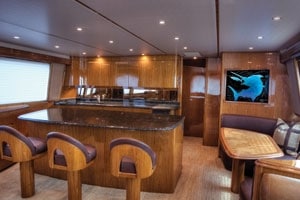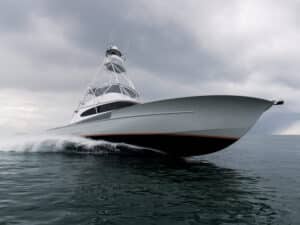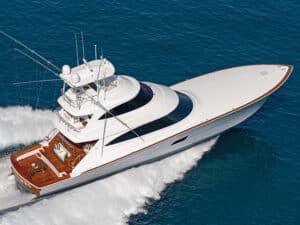
1110br_viking_368
Just when you think you’ve seen the best a company can muster, it comes out with something light-years ahead. Such is the case with the Viking 70.
**Performance
**I tested the 70 out of Cape May, New Jersey, in calm, two- to three-foot ocean swells. The boat carried about 60 percent fluid levels compared to the original factory test (performance report on factory website), which ran the boat completely full. No sane owner ever fills all the tanks completely unless heading on a passage to somewhere very far away.
Idling out at 6.6 knots with one engine in gear provided a very clean wake. I mention this because this is the speed Viking’s factory captain, Ryan Higgins, usually trolls. You can check the performance figures later, but we topped out at just more than 44 knots and cruised most comfortably at about 30.
Viking uses Veem Interceptor props almost exclusively. Ultimately, this boat will end up with six-blade wheels – five blades might be a tad faster, but six blades run smoother.
Three Lenco trim tabs (two outboard and one on centerline) afford a wide range of trim, and you’ll always know where your tabs are positioned thanks to an LCD screen displaying both trim-tab angle as well as an inclinometer. Also, as soon as you shift into neutral, the tabs automatically retract.
Nobody has mastered steering like Viking. The Viking Independent Programmable Electro-Hydraulic Rudder (VIPER) system makes this boat incredibly maneuverable at all speeds, and it improves fuel efficiency at the same time. The VIPER control panel even has a button titled “OK” that automatically centers your rudders.
Running surface improvements include flattening the transom deadrise angle for greater fuel economy and lateral stability while increasing the deadrise forward and at the entry for better head-sea performance. Add the tall freeboard forward, and you get a very dry head-sea boat.
Backing down, I managed just more than 7 knots in total control, while Capt. Higgins says he has hit 11 knots in reverse when fighting fish. The increased roundness in the transom helps the boat move backward quickly. And unless you start backing up-sea and begin taking water over the covering boards, you probably won’t see a drop come up through the scuppers or around the tuna door. With the speed and fuel capacity offered by this boat, suddenly you can consider running out to the canyons – 70 miles out and then back – a day trip.
**Cockpit
**Since you board a convertible from the cockpit, it’s the first place you notice the substantial design differences in this 70. To sum up: Lines that were straight are now round. I can count the number of straight lines in or on this boat on one hand. The windows curve across both the tops and bottoms. Same goes for the tackle center and the arms of the mezzanine settee, the mezzanine steps, the transom, the facing under the mezzanine seats, you name it.
Virtually all the under-seat compartments on the mezzanine contain freezers and refrigerators – some dedicated for baits (rigged and unrigged) and others for food, drinks, etc. Under-gunwale storage lockers hide gaffs, mops, brush heads, chamoises, etc. as well as oil-change quick connects so you don’t have to carry buckets of oil between the dock and the engine room.
Design your fish-box layout however you wish, but they all lift out of the deck (with extra-long drain hoses) and afford incredible under-deck access.
**Engine Room
**Open the hatch, and the fire pull sits close at hand just inside the door. Another trigger mechanism resides on the flybridge. Against the aft bulkhead sit the super-quiet Cummins Onan 27½ kW generators. Under the raised floorboards on centerline, a central seawater system running off a pair of 2 hp pool pumps supplies all raw-water needs except for engine cooling, which is channeled through a single manifold.

The compartment provides almost standing headroom for my 6-foot, 3-inch frame. I found no problem working all the way around both power plants. Viking builds in a level, fiberglass floor outboard of the engines, so you needn’t stand on the angled deadrise of the hull.
Transfer pump solenoids at the front of the compartment connect to the Octoplex electrical distribution system, allowing you to transfer fuel between tanks easily from the flybridge or any other Octoplex display location. Some people have qualms about this system, thinking that it may not be as robust as standard mechanical breakers. Octoplex is, in fact, a mechanical system of sorts. When you activate a solenoid via the LCD display touch screen, the signal ultimately triggers a servo that presses a mechanical breaker. And it saves a ton of wiring weight at the same time.
**Flybridge
**Both entering and exiting the tower (by Palm Beach Towers) feels very secure while under way. And here’s another first: The tower sports radius curves in all the piping. It’s a real nice-looking tower! Murray Brothers’ new series of helm chairs also continues the rounding theme of this Viking.
I really prefer this boat’s center-console helm concept to the standard, broad helm module. The electronics inventory includes three 15-inch KEP monitors. But you almost never have to lift the big, clear door that houses them since controls for the navigation suite reside in boxes on either side of the helm steering pod.
The helmsman enjoys excellent vision fore and aft of the helm thanks to the scallop in the brow on centerline. I appreciated the toe kicks under all the helm and seating modules, and as you move around the bridge, you’ll find that you have more than enough space to pass behind and alongside all the helm pedestal seats.
Viking moved the deep freeze to the brow instead of the helm-module front. It offers much more freezer volume this way and keeps the passengers forward of the helm farther aft so they don’t block the helmsman’s line of sight.
**Interior
**You enter the salon via the Stanley electric door and are instantly greeted by rich fabrics, glossy joinerwork and Amtico vinyl flooring (the new industry standard), which truly looks like real wood. However, if you chip this miraculous new flooring, simply peel up the offending piece and replace it.
The rounding philosophy carries through the interior as well in the cabinetry, counters, the island, companionway and elsewhere. Of course, the L-shaped settee boasts Viking’s signature hinged seatback: The back attaches to the wall, so lift the entire seat bottom and back as one L-shaped piece to reveal the storage beneath. Viking makes terrific use of virtually every square inch of dead space.
Another sign of the times: The only halogen lights aboard are found in the wall sconces in the master stateroom; everything else – including the cockpit floodlights – is LED.
Solid granite counters aren’t as prone to cracking from various flexing stresses over time as shaved granite installations. Of course, no stone comes with a guarantee. Another feature I really appreciate is that Viking never skimps on the size of the bunks. Especially in the single-berth cabins, the bunks are full-size twins.
Regarding the layout, Viking somehow successfully fit the entire Viking 74 interior inside this 70-footer.
**Design and Construction
**

Viking continues its lighter yet stronger quest by sandwiching Baltek end-grain balsa coring between layers of multi-directional fiberglass. All painted surfaces get coated with Awlgrip except for the metallic-black mask across the front of the brow, which is Alexseal. The Baltek in the bottom absorbs impact better than solid fiberglass, and vacuum-bagging it assures optimum glass-to-resin ratios with zero voids. Rest assured, however, that every place there’s a thru-hull or penetration of the hull, you’ll notice that it passes through a core-free, solid-glass area.
It’s interesting to compare the 74 to this 70. The latter sports more rounding everywhere, a considerably higher bow freeboard and a more dramatic taper to the cabin sides. From both a safety and styling perspective, I also like the new flush foredeck.
I have to agree with Capt. Higgins: “I know I seem to say this every time I get a new boat, but this 70 really is my favorite one we’ve ever built!”
Specifications
LOA……70’11”
Beam……19’7″
Draft……5’8″
Deadrise……11.8 degrees
Weight……127,859 pounds
Fuel……2,068 gallons
Water……368 gallons
Power……T 2,600 hp MTU 16V2000 M94 diesels (opt.)
T 1,550 hp MAN V-12 diesels (Std.)
Price……$5,450,786 (as tested)
Viking Yachts / New Gretna, New Jersey / 609-296-6000 / www.vikingyachts.com







